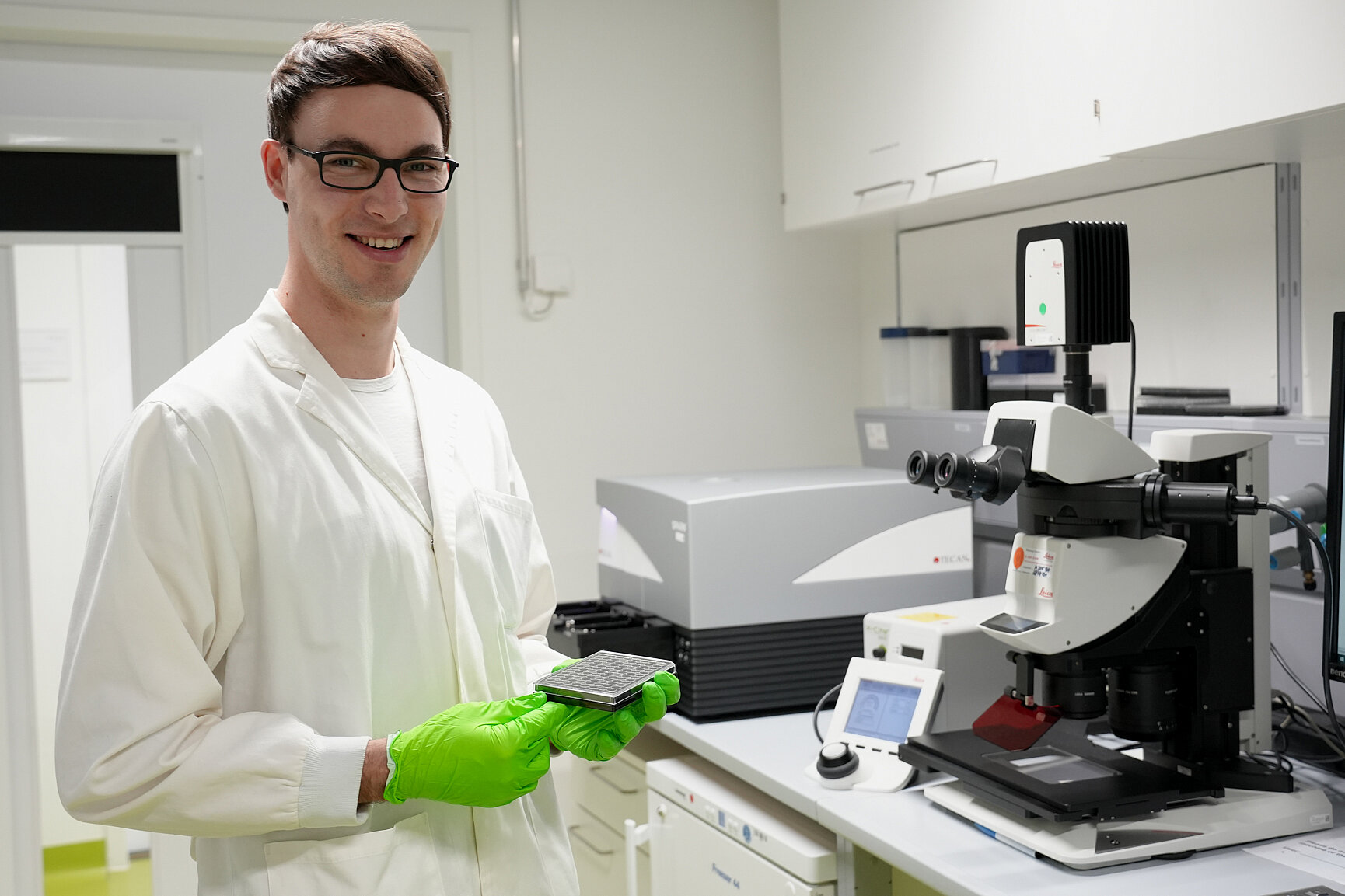

Our Research
The main objects of our research group are the human pathogenic bacteria Staphylococcus aureus and Pseudomonas aeruginosa. These bacteria are among the most feared human pathogens worldwide and are responsible for more than half of all hospital-acquired infections. Of particular concern is the growing number of infections caused by multidrug-resistant strains, which are no longer responsive to conventional antibiotics and often lead to patient death.
It is therefore important to develop new treatment strategies for these pathogens that can be easily applied in clinical practice. To achieve this, a comprehensive and in-depth understanding of the pathophysiology and virulence of these pathogens is urgently needed. We are therefore focusing on elucidating the relationship between the physiology of these pathogens and their ability to colonise their host and cause disease.
The actual effectors in a cell are proteins that are crucial for the interaction of the bacterium with its host. We want to understand which processes in bacteria change during infection, which of these are essential and which proteins are involved. We are not only interested in systematically studying the synthesis and degradation of proteins in bacterial cells, but we are also trying to elucidate the activity and modification of these molecules, as well as the functions they perform during the interaction of these bacteria with their host. In particular, we focus on very small proteins of up to 100 amino acids, which are poorly characterised.
In order to systematically study the abundance, degradation and interaction of proteins in bacterial and eukaryotic cells under infection conditions, as well as the regulation and function of bacterial proteins involved in host adaptation, we have developed several workflows for the global identification and quantification (label-free, TMT, SILAC) of proteins (soluble, secreted and membrane-associated proteins) in bacterial and eukaryotic cells, proteogenomics combined with N-terminomics to identify unannotated small proteins and proteoforms, a metaproteomics approach to study the physiology of bacterial communities, and approaches to identify protein-protein and protein-metabolite interactions.
Our Research
The main objects of our research group are the human pathogenic bacteria Staphylococcus aureus and Pseudomonas aeruginosa. These bacteria are among the most feared human pathogens worldwide and are responsible for more than half of all hospital-acquired infections. Of particular concern is the growing number of infections caused by multidrug-resistant strains, which are no longer responsive to conventional antibiotics and often lead to patient death.
It is therefore important to develop new treatment strategies for these pathogens that can be easily applied in clinical practice. To achieve this, a comprehensive and in-depth understanding of the pathophysiology and virulence of these pathogens is urgently needed. We are therefore focusing on elucidating the relationship between the physiology of these pathogens and their ability to colonise their host and cause disease.
The actual effectors in a cell are proteins that are crucial for the interaction of the bacterium with its host. We want to understand which processes in bacteria change during infection, which of these are essential and which proteins are involved. We are not only interested in systematically studying the synthesis and degradation of proteins in bacterial cells, but we are also trying to elucidate the activity and modification of these molecules, as well as the functions they perform during the interaction of these bacteria with their host. In particular, we focus on very small proteins of up to 100 amino acids, which are poorly characterised.
In order to systematically study the abundance, degradation and interaction of proteins in bacterial and eukaryotic cells under infection conditions, as well as the regulation and function of bacterial proteins involved in host adaptation, we have developed several workflows for the global identification and quantification (label-free, TMT, SILAC) of proteins (soluble, secreted and membrane-associated proteins) in bacterial and eukaryotic cells, proteogenomics combined with N-terminomics to identify unannotated small proteins and proteoforms, a metaproteomics approach to study the physiology of bacterial communities, and approaches to identify protein-protein and protein-metabolite interactions.
Prof Dr Susanne Engelmann
With the help of bacterial genome sequences, a given bacterium’s genetic blueprint is practically handed to us. Its complexity and variability never cease to amaze us and continue to inspire new research questions.

Susanne Engelmann studied biology at the University of Greifswald, earning her Ph.D. at the Institute for Microbiology. In 2001, she became head of the Pathogenomics research unit at the University of Greifswald Institute for Microbiology and, in 2013, was appointed Professor of Microbial Proteome Research at Braunschweig University of Technology. Concurrently, she also holds an appointment as head of the HZI’s Microbial Proteomics Research Group.
Team







Selected Publications
Froschauer, K., S. L. Svensson, R. Gelhausen, E. Fiore, P. Kible, A. Klaude, M. Kucklick, S. Fuchs, F. Eggenhofer, C. Jang, S. Engelmann, R. Backofen, C. M. Sharma. 2025. Complementary Ribo-Seq approaches map the translatome and provide a small protein census in the foodborne pathogen Campylobacter jejuni. Nat. Comm. 16:3078. doi: 10.1038/s41467-025-58329-w
Fuchs, S., M. Kucklick, E. Lehmann, A. Beckmann, M. Wilkens, B. Kolte, A. Mustafayeva, T. Ludwig, M. Diwo, J. Wissing, L. Jänsch, C.H. Ahrens, Z. Ignatova, and S. Engelmann. 2021. Towards the characterization of the hidden world of small proteins in Staphylococcus aureus, a proteogenomics approach. PloS Genetics. 17(6):e1009585. doi: 10.1371/journal.pgen.1009585.
Bartholomäus, A., B. Kolte, A. Mustafayeva, I. Goebel, S. Fuchs, D. Benndorf, S. Engelmann, Z. Ignatova. 2021. smORFer: a modular algorithm to detect small ORFs in prokaryotes. Nuc. Acid Res. 49:e89. doi: 10.1093/nar/gkab477.
Selle M., Hertlein T., Oesterreich B., Klemm T., Kloppot P., Müller E., Ehricht R., Stentzel S., Bröker B.M., Engelmann S., Ohlsen K. (2016) Global antibody response to S. aureus live-cell vaccination. Sci Rep 6:24754.
Boedeker C., Schüler M., Reintjes G., Jeske O., van Teeseling M., Jogler M., Rast P., Borchert D., Devos D.P., Kucklick M., Schaffer M., Kolter R., van Niftrik L., Engelmann S., Amann R., Rhode M., Engelhardt H., Jogler C. (2017) Determining the bacterial cell biology of Planctomycetes. Nat Commun 8:14853.


